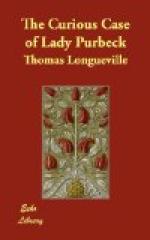This exclusion from her party was a direct and a very public insult to Coke on the part of his wife, and, through consent, on that of the King also. All Coke had gained by his daughter’s marriage with Sir John Villiers was restoration to the Privy Council. As he had made up his mind to take his daughter to market, he should have made certain of his bargain. This he failed to do. As has been shown, he promised L10,000 down with her and L1,000 a year. This Buckingham did not consider enough; but Coke refused to promise more, declaring that he would not buy the King’s favour too dear. In a letter to Carleton, Chamberlain says that, if he had not “stuck” at this, Coke might have been Lord Chancellor. As it was, he incurred the whole odium of having sold his daughter, while his wife, who had gained the credit of protesting against that atrocious bargain, quietly pocketed its price in the coin of royal favour. Lady Elizabeth not only embroiled her own family, but also brought discord about her affairs into the family of another, as may be inferred from the following letter:—[41]
“Elizabeth, Lady Hatton, to Carleton.
“MY LORDE,
“I understande by your letter the quarrell of unkindness betweene yourself and your wife, but having considered the cause of the difference to proceed only from your loving respect shewne towards me, I hope that my thankfulle acknowledgements will be sufficient reconcilement to give you both proceedings for the continuance of your wonted goode wille and affectione ... even though I understande by your letter you thinke women to be capable of little else but compliments. Wherefore to express a gracious courtesie for your kindness as in the few wordes I am willing to utter you may assure yourselfe yt my desire is to remayne
“Your
assured loving Frend
“(Signed) ELIZA
HATTON.
“HATTON HOUSE “20th March 1618.”
One naturally wonders whether, if Carleton showed this letter to his wife, it would tend to heal “the quarrell of unkindness” between them, or to make it worse. Which effect was intended by the writer of the letter is pretty evident. This little epistle might have been written by Becky Sharpe.
FOOTNOTES:
[32] Coles’ MSS., Vol. XXXIII. p. 17.
[33] Coles’ MSS., Vol. XXXIII., p. 17. (Brit. Museum MSS. No. 5834.)
[34] Longmans & Co., 1811.
[35] S.P. Dom., James I., Vol. XCIII., No. 114, 6th October, 1617.
[36] S.P. Dom., James I., Vol. XCIII., No. 158, 31st Oct., 1617.
[37] S.P. Dom., James I., Vol. XCIV., 15th November, 1617.
[38] Vol. I., p. 5.
[39] S.P. Dom., James I., Vol. XCIV., No. 30, 15th November, 1617. Chamberlain to Carleton.
[40] S.P., XCIV., No. 15.
[41] S.P. Dom., James I., Vol. XCVI., No. 69.




